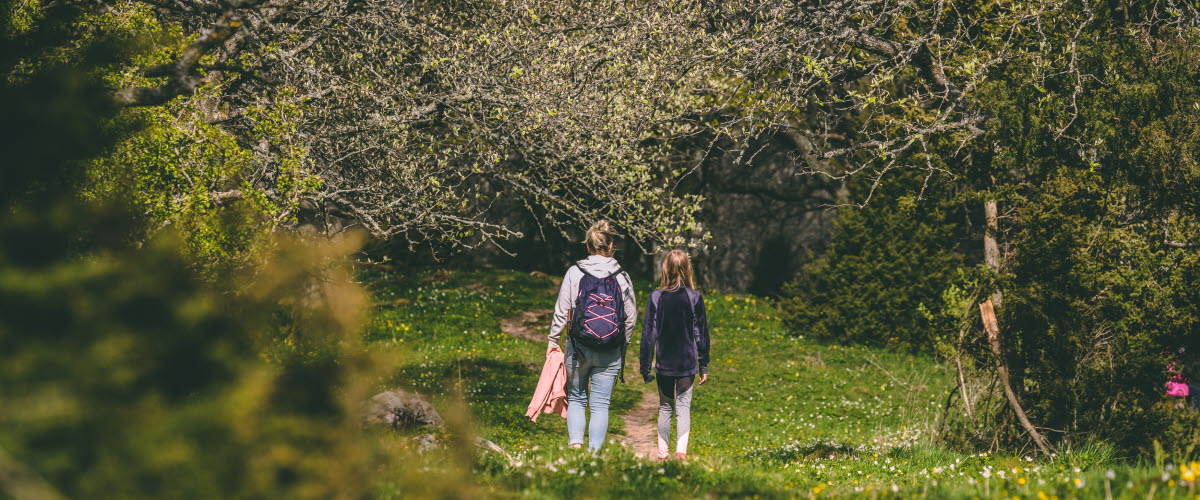The Valle District – eight different nature reserves
On the western face of mount Billingen, the last ice age has left behind the unique Valle District, an area of lakes and gently rolling hills.
Varied landscape
When the massive ice sheet melted away around 10,000 years ago, the climate turned colder over the following centuries. The ice therefore remained and large rivers and icebergs formed in the ice, together with sand and gravel, creating the hilly Valle landscape known as kame in geological terms. A warren of gravel ridges, hills, moraines, eskers, and plateaus frame valleys with lakes or swamps. The landscape is very varied in that meadows, fields, and pastures mix with lakes and trees. Six separate natural reserves, all with different flora and fauna, make up this small district of around 1,100 ha. Old cultural landscape with pastures, cairns, rock walls, and copses.
Bockaskedeåsen - Björnabacken
A ridge with an icy history
Bockaskedeåsen is a protruding ridge that was formed at the end of the last ice age, some 10,000 years ago. The ridge is appr. 600 m long and appr. 35 metres tall. That makes it the tallest and most pronounced ridge in the Valle District. It is covered in pastures. Björnabacken is a steep slope with a few extended hills. It is mostly fields and pastures with some copse vegetation.
Eahagen - Öglunda ängar
Deciduous forest with near tropically abundant vegetation
Eahagen - Öglunda ängar is in the centre of the Valle District, near the lakes Ämten and Flämsjön. On the isthmus between the lakes is the actual Eahagen, a copse with trees like oak, alm, lime, and wild cherry. The flora, nurtured by the lime in the ground, is rich. In spring, the landscape comes alive with spring pea, lungwort, and coralroot.
Nature’s Treasure Chest
The reserve, home to the most valuable parts of the district from a natural standpoint, is a well-preserved old cultural landscape with a mosaic of fields, pastures, and deciduous forests. In the reserve are also two grave fields from the Iron Age, and some individual graves. The vegetation is lush, with many lime-loving species that are unusual in other places. Spring and early summer is recommended for flower-lovers. A hiking trail, Valle Vandring, runs through the area. It starts from Flämslätt and extends for about 10 km. The forest birdlife is rich. You may for example expect to see wryneck, wood warbler, nightingale, and several species of woodpecker.
Höjentorp - Drottningkullen
The old castle ruin of Höjentorp, dating back to the 13th century, is in the largest of the six nature reserves in Valle. The castle was supposedly donated to the Bishop of Skara in 1284, but was later taken back into State ownership under the reforms of King Gustav Vasa. In the middle of the 17th century, the castle was gifted as dowry by Queen Kristina to the wife of Magnus Gabriel de la Gardie, Maria Eufrosyne. The castle burned to the ground in 1722, supposedly while visited by Queen Ulrika Eleonora. She is said to have watched the fire from a nearby hill, which was later named Queen’s Hill – Drottningkullen.
An important place during the Middle Ages
Today, only three sections of the ruined cellar remain, but the place bears witness of its importance during the Middle Ages, a time when also Skara flourished. There are beautiful ash and lime trees in the wild-growing castle garden, and on the slope down to Lake Trädgårdssjön, the air is filled with the scent of ramson and other exotic herbs. Carl Linnaeus wrote, during his trip through Västergötland in 1746: “Höjentorp was in the most pleasant place and enjoyed the loveliest location.”
Agricultural college during the 18th century
At the northern end of Lake Trädgårdssjön, you will find the castle ruin of Höjentorp. Within walking distance of the ruin is the old Farm Höjentorp. The “potato king” Jonas Alströmer ran an agricultural college here in the 18th century. The reserve boasts the most hilly and lake-rich parts of the Valle District.
More options for hiking and rambling
The most pronounced kame landscape in the county is at the northeastern end of the reserve. The ground is rich in limestone, and this is noticeable through the limescale in the lakes and the presence of mussels, shells, and stonewort. The cultural landscape is unusually diverse and partly medieval. Several walking trails exist. It is also possible to walk following trails on the meandering, grazed ridges in the south of the reserve.
Jättadalen - Öglunda cave
If you are looking for a more challenging natural experience, we recommend Jättadalen (The Giant’s Valley), a deep ravine surrounded by diabase precipices. The ascent to Jättadalen is steep and moderately strenuous. But you can catch your breath and fill up from a natural source with fresh water emerging from the shale. At the summit, you are rewarded with breathtaking views over the Valle District with its mosaic of lakes, forests, and pastures, with Mount Kinnekulle visible in the distance. Well worth the effort!
Caves and chasms
Jättadalen is on the western face of Mount Billingen. It is the very hard diabase on top of the Västgöta mountains that has protected them from erosion by ice, wind, and water.
Here at Jättadalen, the diabase form vertical cliffs with pillars and gorges. At the foot of the gorges are large, angular diabase boulders. From the vantage point above Jättadalen, the walking trail continues south. If you follow this path, you will eventually arrive at Öglunda Cave, which is like a ravine. Giant diabase boulders form cave-like rooms. There are also detached pillars, formed of diabase.
The “Valle Vandring”-trail passes through Jättadalen. It starts from Flämslätt Conference Centre and extends for 10 km.
Lycke – Lilla Höjen
This nature reserve is dominated by an ancient cultural landscape with fields, open pastures, and deciduous forest. The top of the ridge affords a magnificent view of the surroundings.
Torprännan
The reservation is a well-preserved and representative part of mount Billingen’s west face, with a deep valley, Torprännan, at its foot. Torprännan and some smaller valleys on the hillside, were created by mighty waterflows at the end of the ice age.
Foundations and vacant lots
At the very top, the diabase has created a marked edge. Lower lying parts are dominated by open fields and pastures, which at higher altitudes turn into groves with oak trees. Pin cherry is commonly found here, but the diabase edge is covered in pine forest. On the slope are some old cottages, foundations, and vacant lots from earlier habitation.
The Cavalry Captain’s Residence
The main building of Torp Farm was erected in the 18th century and features preserved decorative details in the Empire style from early 19th century. The other buildings are also early 19th century. The farm served as the residence of the Cavalry Captain of the Royal Västgöta Regiment, based at Axvalla Hed. The buildings and the surrounding gardens are rich in artefacts.
A hiking trail crosses the pastures into a hilly landscape with pastures and leafy copses, habitat to hawfinch and spotted nutcracker.
There is a marked path from the car park, near the public road, into the reserve.
Ökull – Borregården
Ökull Farm belonged to the Crown in the Middle Ages. The King would arrive on horseback with his entourage to visit his representative living on and working the farm. In the 16th century, Ökull was transformed into a village, which 300 years later turned into a farming estate.
The grounds surrounding Borregården Farm probably used to belong to Varnhem Monastery before they were taken over by private owners.
In this reserve, you will find moist lime meadows, fens, natural pastures and deciduous forest. There is also a rich flora of mushrooms, moss, and vascular plants. Stonewort, which requires clear water, flourishes in the lakes.
The most pronounced ridge in the kame landscape is called Getaryggen, which can be followed for appr. 5 km to the north.
Vingängen
The natural reserve of Vingängen was created by Skara Council. It is characterised by oak- and birchtree-lined pasture, grazed by cows and horses. Several other species of trees can also be found here, such as Swedish whitebeam, maple, lime-tree, and rowan. Eight of the oaks are so-called “giant trees”. For an oak, that means a circumference of at least 6 metres!
Several rare species of lichen and moss thrive on these large, ancient trees. Many interesting species live in the field layer, such as thyme, arnica, scabiosa, alpine bistort, nardus, and catsfoot.
In the western part of the reserve is a mixed pine forest with some leafy trees. Forestry has taken its toll. But in time, the forest will regrow and the proportion of deciduous forest will increase. In the northern part of the reserve are some fields and pastures.
In summer, cows graze the eastern part of the reserve. This part is very rich in ancient monuments and other cultural and historical remnants, such as ancient fields, prehistoric graves, foundations, and cairns. These are probably remnants of the ancient/medieval village of Norra Ving.






